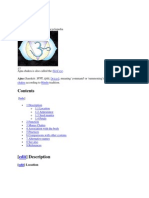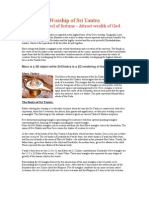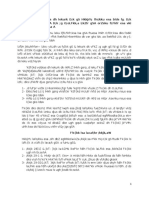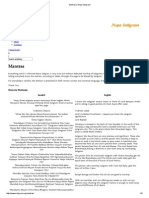Muladhara
Muladhara
Uploaded by
Basant KumarCopyright:
Available Formats
Muladhara
Muladhara
Uploaded by
Basant KumarOriginal Description:
Copyright
Available Formats
Share this document
Did you find this document useful?
Is this content inappropriate?
Copyright:
Available Formats
Muladhara
Muladhara
Uploaded by
Basant KumarCopyright:
Available Formats
Muladhara is the root centre of physical experience, located at the base of the spine, the sacral
plexus. The square represents the earth itself, the four dimensions and the four directions. Four
allows for completion, and earth embodies the elements and conditions for human completion on
all levels. Patience and greed are the attributes of this element, survival its desire, collecting and
saving are its activity. Muladhara Chakra is the meeting place of the three main nadis: Ida, Pingala
and Sushumna. The downward-pointing triangle indicates the downward movement of energy and
the three main nadis. The seed mantra is Lam, the yellow square represents the earth element. The
Muladhara chakra governs the vital breath Apana. An inverted triangle in the centre of the square
encloses the unmanifest Kundalini, represented as a snake wrapped in three and a half coils around
the svayambhu (self born) linga. Because her mouth faces downward, the flow of energy is
downward. As soon as one begins working with Muladhara chakra, this dormant energy raises its
head and flows freely into the channel of Sushumna, the central nerve canal that runs along the
spine. In the pericarp is found the presiding deity Brahma, the lord of creation. His skin is the
color of wheat, he wears a yellow dhoti (traditional Indian cloth wrapped to cover the lower body)
and a green scarf. Brahma is four-faced, four-armed, holding in his upper left hand a lotus flower,
the symbol of purity. In his second left hand he holds the sacred scriptures. In one right hand he
has a vase containing nectar, this is amrita the precious fluid of vital potency. The fourth hand is in
Abhaya mudra, the gesture of dispelling fear. The energy, or shakti, of Brahma is called Dakini.
She is in shining pink with four arms holding a skull, a sword, a shield and a trident symbolizing
the forces of the creator, the preserver and the destroyer.
Location: Base of the spine Name: Foundation The chakra's associated animal is Ganesha, the
elephant headed god. Ganesha is the lord of all beginnings and is invoked to bestow protection
over all undertakings. His skin is coral orange. He wears a dhoti of lemon yellow color. A green
silk scarf drapes his shoulders. He has four arms to serve him while he acts as the destroyer of
obstacles. Ganesha is the son of shiva and parvati. He holds a ladu (a fragrant sweet symbolizing
sattva, the most refined state of pure consciousness), a lotus flower, a hatchet. The fourth hand is
raised in the mudra of dispelling fear.
You might also like
- Devi Mahatmyam Book PDFDocument55 pagesDevi Mahatmyam Book PDFaciyer100% (6)
- Chakrasamvara Luipa ABShort Low ResDocument14 pagesChakrasamvara Luipa ABShort Low ResLim Kew Chong100% (9)
- Samita Dhanam-Upakarmam Eng PDFDocument5 pagesSamita Dhanam-Upakarmam Eng PDFMsanket Nayak0% (1)
- Miracle of YantrasDocument3 pagesMiracle of YantrasSelvarajoo Vayapury50% (2)
- Math Behind Sri YantraDocument16 pagesMath Behind Sri YantraVidya Warrier100% (1)
- Sri Yantra Simple RitualDocument5 pagesSri Yantra Simple RitualDevender Singh100% (1)
- Vajrayogini: Her Visualization, Rituals, and FormsFrom EverandVajrayogini: Her Visualization, Rituals, and FormsRating: 4.5 out of 5 stars4.5/5 (10)
- Tara Brihad Nila TantraDocument4 pagesTara Brihad Nila TantraAnton Arsen75% (4)
- Mantras GaneshaDocument6 pagesMantras GaneshaBarbatul Viril PotentNo ratings yet
- Chakra 2Document2 pagesChakra 2Adhyatma Yoga RahasyaNo ratings yet
- Chakra 5Document3 pagesChakra 5Adhyatma Yoga RahasyaNo ratings yet
- Sri Yantra - The Significance and Symbolism of Its Design: The Cosmos in Abstract FormDocument8 pagesSri Yantra - The Significance and Symbolism of Its Design: The Cosmos in Abstract FormJyotindra100% (3)
- Anahata - WikipediaDocument9 pagesAnahata - Wikipediaap4449911No ratings yet
- Muladhara ChakraDocument3 pagesMuladhara ChakranieotyagiNo ratings yet
- Yantra As MeditationDocument10 pagesYantra As MeditationSean Griffin100% (2)
- Sat-Chakra-Nirupana: (By Purnananda Swami) 7 ChakrasDocument14 pagesSat-Chakra-Nirupana: (By Purnananda Swami) 7 ChakrasSudhanshu GoswamiNo ratings yet
- KalaavahnaDocument10 pagesKalaavahnaRakesh Singh100% (1)
- Manipura ChakraDocument3 pagesManipura ChakranieotyagiNo ratings yet
- Lotus DietyDocument85 pagesLotus DietyWistara Iswantoro100% (2)
- ManjushriDocument2 pagesManjushriAndre HscNo ratings yet
- Sri YantraDocument3 pagesSri Yantramukti banaNo ratings yet
- Bhavana UpanishadDocument2 pagesBhavana UpanishadSoftbrainNo ratings yet
- Dr. Muralidhar N-Shat ChakraDocument41 pagesDr. Muralidhar N-Shat Chakravikram goshanNo ratings yet
- Chapter - III: 1. Place of Symbolism and It's RelevanceDocument71 pagesChapter - III: 1. Place of Symbolism and It's Relevanceindrani royNo ratings yet
- Bija MantrasDocument6 pagesBija Mantrasleversoft2012No ratings yet
- Tripura Moola Mantra Should Recited 2Document25 pagesTripura Moola Mantra Should Recited 2PericoiNo ratings yet
- ShivaDocument6 pagesShivaMelissa JansenNo ratings yet
- Sanskrit Iast Adi Parashakti Parvati Decline of Buddhism in IndiaDocument2 pagesSanskrit Iast Adi Parashakti Parvati Decline of Buddhism in Indiaram179No ratings yet
- Ajna ChakraDocument3 pagesAjna ChakranieotyagiNo ratings yet
- Bija MantrasDocument6 pagesBija Mantrassrinath247No ratings yet
- A Summary of The Stages of Visualization For Longchen Nyingthig Ngundro PracticeDocument10 pagesA Summary of The Stages of Visualization For Longchen Nyingthig Ngundro Practicepurpletara100% (1)
- Description of ChakrasDocument14 pagesDescription of ChakrasAkshay SinghNo ratings yet
- 7 ChakrasDocument17 pages7 ChakrasSanjeev.108No ratings yet
- Ebold7 2 03Document41 pagesEbold7 2 03Espaço Terapêutico Sintilla Lux LuxNo ratings yet
- From Wikipedia, The Free Encyclopedia: (A ɟƝɅ) Chakra HinduDocument4 pagesFrom Wikipedia, The Free Encyclopedia: (A ɟƝɅ) Chakra HinduprasadkulkarnigitNo ratings yet
- Goddess Lalitha TrishatiDocument3 pagesGoddess Lalitha TrishatiBryanNo ratings yet
- Tara 21taras Short Commentary On The Tantra of Twenty One Homages To TaraDocument19 pagesTara 21taras Short Commentary On The Tantra of Twenty One Homages To TaraJarosław ŚunjataNo ratings yet
- Worship of Sri YantraDocument4 pagesWorship of Sri YantraVikram Gopal100% (2)
- Chakra 4Document2 pagesChakra 4Adhyatma Yoga RahasyaNo ratings yet
- BijabookDocument21 pagesBijabookdynamic2004100% (1)
- Buddhist DeitiesDocument13 pagesBuddhist DeitiesShaman Vajra Wolf100% (1)
- Symbolism of VinayagamurthyDocument4 pagesSymbolism of VinayagamurthySivason100% (1)
- Nath ParamparaDocument25 pagesNath ParamparadiiptdasvNo ratings yet
- 21 TarasDocument30 pages21 TarasSzabó Csaba László75% (4)
- Ajna ChakraDocument4 pagesAjna ChakraDiego Vazquez100% (1)
- Kali Nityas MantrasDocument13 pagesKali Nityas Mantrasliaya76No ratings yet
- ChakraDocument5 pagesChakraChester TanNo ratings yet
- Shri Yantra 2 BookDocument245 pagesShri Yantra 2 BookUday DokrasNo ratings yet
- The Seven ChakrasDocument2 pagesThe Seven Chakrashotei_oshoNo ratings yet
- Chinnamasta SarvaswamDocument115 pagesChinnamasta Sarvaswamadithya4raj100% (7)
- Chakra Trigger PointsDocument3 pagesChakra Trigger PointsSonali FoxNo ratings yet
- TrimurtiDocument2 pagesTrimurtiCyenna Norein SagucioNo ratings yet
- Chakras Am Vara Lui Paab ShortDocument14 pagesChakras Am Vara Lui Paab ShortStephen ComeeNo ratings yet
- Great VidyaDocument8 pagesGreat Vidyasmiles789100% (2)
- Exploring Mysticism: A Methodological EssayFrom EverandExploring Mysticism: A Methodological EssayRating: 3.5 out of 5 stars3.5/5 (3)
- Chakra: Learning your energies to find balance, health and happinessFrom EverandChakra: Learning your energies to find balance, health and happinessRating: 4 out of 5 stars4/5 (2)
- Paper 1 Sec. PartDocument6 pagesPaper 1 Sec. PartBasant KumarNo ratings yet
- Isij 3 " KSF (KD Vuqla/Kku DH Fof/K K¡Document16 pagesIsij 3 " KSF (KD Vuqla/Kku DH Fof/K K¡Basant KumarNo ratings yet
- Interviewing Skills: Suitable For Senior, Middle Managers and SupervisorsDocument1 pageInterviewing Skills: Suitable For Senior, Middle Managers and SupervisorsBasant KumarNo ratings yet
- Frequently Asked Questions (Faqs) (New Pension Scheme) : Last Updated/Reviewed: 04.11.2013Document1 pageFrequently Asked Questions (Faqs) (New Pension Scheme) : Last Updated/Reviewed: 04.11.2013Basant KumarNo ratings yet
- EPCODocument1 pageEPCOBasant KumarNo ratings yet
- History and Development of Social Work: Assignment Question Paper - IDocument5 pagesHistory and Development of Social Work: Assignment Question Paper - IBasant KumarNo ratings yet
- School Plus MuskanDocument3 pagesSchool Plus MuskanBasant KumarNo ratings yet
- An Awesome Lecture by Field Marshal Sam Manekshaw's Lecture at Defence Services CollegeDocument6 pagesAn Awesome Lecture by Field Marshal Sam Manekshaw's Lecture at Defence Services CollegeBasant KumarNo ratings yet
- CDMA 2000 1x Based EVDO Rev A Data Card Make: Easlink Info Limited. Model: UE100Document13 pagesCDMA 2000 1x Based EVDO Rev A Data Card Make: Easlink Info Limited. Model: UE100Basant KumarNo ratings yet
- Google Input ToolDocument3 pagesGoogle Input ToolBasant KumarNo ratings yet
- Urban Transport - How To Address The Commercial Road BlocksDocument20 pagesUrban Transport - How To Address The Commercial Road BlocksBasant KumarNo ratings yet
- 1874 1187 Lla110107 PDFDocument1 page1874 1187 Lla110107 PDFBasant KumarNo ratings yet
- Welcome: Asia BRTS Conference 2012 AhmedabadDocument29 pagesWelcome: Asia BRTS Conference 2012 AhmedabadBasant KumarNo ratings yet
- What's An Ecocity and Why Should We Care?: Comments Warren Karlenzig 0Document6 pagesWhat's An Ecocity and Why Should We Care?: Comments Warren Karlenzig 0Basant KumarNo ratings yet
- Landsat's Critical Role in Urban Planning: Hot Times in The CityDocument2 pagesLandsat's Critical Role in Urban Planning: Hot Times in The CityBasant KumarNo ratings yet
- NamesDocument6 pagesNamesPalaniraja ChandrasekaranNo ratings yet
- A List From LalitopakhyanamDocument8 pagesA List From Lalitopakhyanamviswanath venkiteswaran100% (1)
- Thiruvathirai VrathamDocument6 pagesThiruvathirai VrathamKalyani MoorthyNo ratings yet
- Baladeva Vidyabhusana Sri Vedanta SyamantakaDocument34 pagesBaladeva Vidyabhusana Sri Vedanta SyamantakaJSKNo ratings yet
- BAJANSDocument26 pagesBAJANSnarayanaswamyNo ratings yet
- Bhawani AstakamDocument4 pagesBhawani Astakamdd bohraNo ratings yet
- Lalita Stava Ratnam Arya Dvishati Eng v1Document26 pagesLalita Stava Ratnam Arya Dvishati Eng v1A Soni100% (1)
- Yagati in Kadur Taluk of Chikmagalur District Recorded Maximum Rainfall of 107Document5 pagesYagati in Kadur Taluk of Chikmagalur District Recorded Maximum Rainfall of 107WebcomCyberCafeNo ratings yet
- JyotirlingaDocument4 pagesJyotirlingaMukesh YadavNo ratings yet
- Bhajans NewDocument42 pagesBhajans NewMuralidhar Ramalingam67% (12)
- Daily PrayersDocument74 pagesDaily Prayersrickyreema67% (3)
- Lakshmi Dwadasa Nama Stotram: How Will Lakshmi Herself Worship You?Document10 pagesLakshmi Dwadasa Nama Stotram: How Will Lakshmi Herself Worship You?vlaxmanan80% (5)
- Mantra For A ChildDocument3 pagesMantra For A Childda_reaper_dasNo ratings yet
- Dasa MahavidyaDocument13 pagesDasa Mahavidyamusiboyina100% (1)
- SMS Templetes-New For DetailsDocument5 pagesSMS Templetes-New For DetailsDeekshith DeekuNo ratings yet
- BooksDocument1 pageBooksVedic Gemstone HealerNo ratings yet
- 012 NavadurgaDocument13 pages012 NavadurgaCuriosityShopNo ratings yet
- The Moon As A Goddess in Vedic AstrologyDocument11 pagesThe Moon As A Goddess in Vedic AstrologyRajeswara Rao Nidasanametla100% (4)
- Devi Atharvashirsha PDFDocument9 pagesDevi Atharvashirsha PDFatulchokshi0% (1)
- Kalender Bali 2012 SingleDocument12 pagesKalender Bali 2012 SingleTut AdiNo ratings yet
- 108 Names of Durga, Durga P...Document4 pages108 Names of Durga, Durga P...রোহন করNo ratings yet
- Invitation - TamilDocument3 pagesInvitation - TamilGomathi NarayananNo ratings yet
- The Saligram StrotraDocument3 pagesThe Saligram Strotraqlnet100% (1)
- Sri Guhya KaliDocument2 pagesSri Guhya KaliSathis Kumar100% (1)
- 7 ReportDocument6 pages7 ReportsriNo ratings yet
- Powerful Durga Mantras - in English - Sanskrit With Meaning For ProtectionDocument10 pagesPowerful Durga Mantras - in English - Sanskrit With Meaning For ProtectionRohit Singh100% (1)








































































































